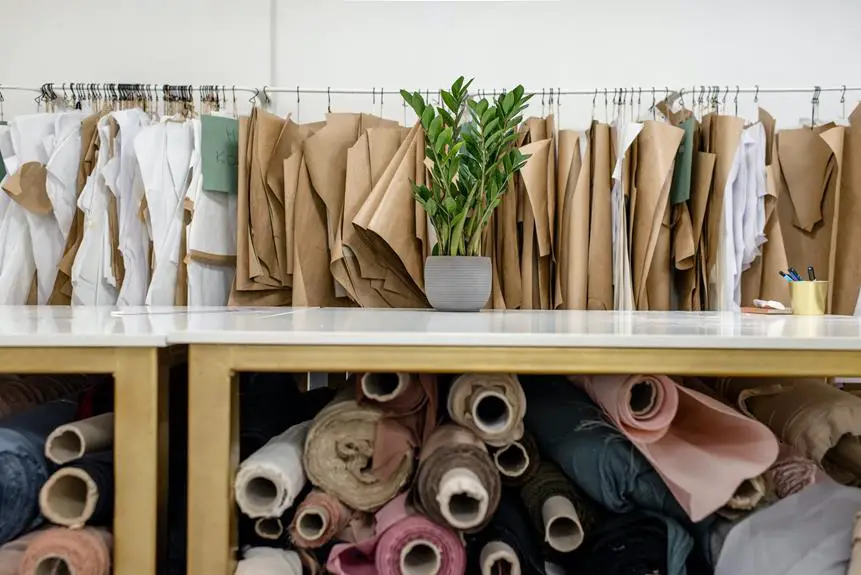Hey there! Wondering if you can starch linen? Look no further!
Mastering the art of starching linen can elevate your garment game to new heights. From understanding the unique properties of linen fabric to choosing the right type of starch, we've got you covered.
This guide will walk you through the pros and cons of starching, the different methods, and tips for achieving that perfectly crisp look. We'll also debunk common misconceptions and offer alternatives for those seeking a more relaxed approach.
Get ready to delve into the world of starched linen and take your fabric care skills to the next level!
Key Takeaways
- Starching linen can enhance crispness and structure, making it ideal for formal occasions and improving resistance to wrinkles.
- However, over-starching can lead to potential discomfort due to stiffness and increased susceptibility to attracting dirt and dust.
- Starching linen can weaken the fabric over time and may cause yellowing if excessive starch is used.
- Delicate care techniques are necessary for fabric preservation, and it can be challenging to remove excess starch.
Understanding Linen Fabric Properties
You can identify linen fabric by its natural luster and exceptional breathability. Linen is known for its ability to keep you cool and comfortable, making it a popular choice for warm-weather clothing and bedding.
When it comes to linen care and fabric maintenance, there are a few key things to keep in mind to ensure that your linen items remain in top condition.
To maintain your linen fabric, it's important to follow the care instructions on the label. Typically, linen should be hand or machine washed in cold water with a gentle detergent. Avoid using bleach as it can weaken the fibers and cause discoloration. It's best to air dry your linen items to prevent shrinkage, but if you need to use a dryer, opt for a low heat setting.
To keep your linen looking crisp and wrinkle-free, you can iron it while it's still slightly damp. Alternatively, embrace the natural wrinkles for a more relaxed look.
Proper linen care and fabric maintenance will ensure that your linen pieces remain beautiful and durable for years to come.
Pros and Cons of Starching Linen
Considering whether to starch your linen?
Starching linen can give it a stiffer, more elegant look, but it also comes with potential fabric damage.
Let's explore the pros and cons of this process to help you make an informed decision.
Stiffer Fabric, Elegant Look
To achieve a stiffer fabric and an elegant look, consider the pros and cons of starching linen. Starching linen can enhance the appearance of the fabric, giving it a crisp and polished finish. However, it's important to weigh the benefits against potential drawbacks before deciding to starch your linen.
Here are some pros and cons to consider:
- Pros:
- Enhanced crispness and structure
- Improved resistance to wrinkles
- Elevated elegance for formal occasions
- Long-lasting effects with proper care
- Cons:
- Potential stiffness may be uncomfortable for some
- Increased susceptibility to attracting dirt and dust
- Extra care required to avoid flaking or yellowing
- Over-starching can lead to fabric damage
Carefully assessing these factors will help you determine whether starching linen aligns with your preferences and needs.
Potential Fabric Damage
When starching linen, it's important to carefully consider the potential fabric damage that may result, especially as we've discussed the enhanced crispness and structure it can provide. Here's a table outlining the pros and cons of starching linen:
| Pros | Cons |
|---|---|
| Enhanced crispness | Fabric weakening over time |
| Improved structure | Potential yellowing with excessive starching |
| Professional appeal | Difficulty in removing excess starch |
| Easier to iron | Risk of attracting more dirt and dust |
| Fabric preservation | Increased stiffness over time |
To maintain your linen's longevity, delicate care techniques such as proper starch dilution and thorough rinsing are essential. While starching can enhance the fabric's appearance, it's crucial to weigh the potential fabric damage against the desired benefits.
Types of Starch for Linen
You can use three primary types of starch to stiffen linen: liquid starch, spray starch, and powder starch. Each type offers different benefits and application methods for achieving the desired level of stiffness and wrinkle prevention for your linen.
Here's a breakdown of each type:
- Liquid Starch: This type of starch is mixed with water and then applied to the linen by soaking or dipping, allowing for a thorough and even distribution of starch. It's ideal for achieving a crisp finish on larger linen items like tablecloths and curtains.
- Spray Starch: Convenient and easy to use, spray starch is applied directly to the fabric in a fine mist. This type of starch is perfect for smaller linen items like napkins and shirts, allowing for targeted application and control over the level of stiffness.
- Powder Starch: Powder starch is mixed with water to create a starch solution, providing flexibility in adjusting the concentration for different levels of stiffness. It's suitable for both large and small linen items and offers versatility in application.
Conclusion:
Each type of starch offers unique benefits and application methods, allowing you to customize the level of stiffness and wrinkle prevention for your linen based on your specific needs.
The Starching Process for Linen
Ready to learn how to perfect the art of starching your linen?
Let's talk about the different techniques for applying starch to your linens.
The benefits of starching.
How to choose the right type of starch for different linens.
Starch Application Techniques
To achieve optimal results when starching linen, apply the starch using a spray bottle in an even, light mist. This ensures consistent coverage and prevents over-saturation. Here's a simple guide to help you master the starch application process:
- Prepare the linen: Ensure the fabric is clean and thoroughly dry before applying starch to avoid trapping any dirt or moisture.
- Test in an inconspicuous area: Before applying starch to the entire garment, test a small area to ensure the desired level of stiffness and to check for any adverse effects on the fabric.
- Even application: Hold the spray bottle about 6-8 inches away from the fabric and apply the starch in a sweeping motion, maintaining a consistent distance to achieve uniform coverage.
- Allow drying time: After applying the starch, allow the linen to air dry completely before ironing to achieve the desired crispness.
Mastering these techniques will enhance the effectiveness of starch application and contribute to proper linen care and maintenance.
Benefits of Starching
Exploring the benefits of starching linen enhances its durability and provides a smoother, more polished appearance. By employing professional starching techniques or utilizing professional services, you can achieve the following advantages:
| Benefits | Description |
|---|---|
| Enhanced Durability | Starching linen helps it withstand wear and tear, extending the lifespan of your linens. |
| Crisp Appearance | Linens come out of the laundry with a fresh, pressed look, maintaining a professional appearance. |
| Easier Ironing | Starched linens are easier to iron, saving you time and effort during the laundry process. |
When considering the environmental impact and cost comparison, professional services may be more efficient and eco-friendly in managing the starching process, while also providing consistent and high-quality results.
Starching for Different Linens
When starching different linens, adjust the starching process based on the fabric's weight and weave for best results. Linen care requires understanding the fabric properties and how they affect the starching process.
Here are some tips for starching different linens:
- Lightweight Linens: For lightweight linens, use a lighter starch solution to avoid making the fabric stiff. A spray starch can be an effective alternative method for achieving a light, even coating.
- Medium-weight Linens: Medium-weight linens can handle a slightly heavier starch. Consider using a liquid starch for a more substantial finish.
- Heavyweight Linens: Heavyweight linens can withstand a heavier starch solution. A traditional starching technique, such as dipping and soaking the fabric, can provide a crisp, structured result.
- Delicate Weaves: Delicate weaves, such as herringbone or jacquard, may require a gentler approach. Opt for a starch alternative, like homemade rice starch, to avoid damaging the intricate weave.
Understanding these techniques will ensure that you achieve the desired level of crispness while maintaining the integrity of your linens.
Tips for Achieving the Perfectly Starched Look
To achieve the perfectly starched look, start by selecting a heavy-duty spray starch suitable for linen. When applying the starch, hold the can about six to eight inches away from the fabric and spray in a sweeping motion to ensure even coverage.
It's essential to use a hot iron to set the starch into the linen properly. Set your iron to the linen setting and press down firmly, moving slowly to allow the heat to activate the starch.
For a more natural approach, you can create a starch solution by dissolving cornstarch or rice starch in water and then applying it to the linen with a spray bottle or by soaking it before ironing. This method allows you to achieve subtle, elegant stiffness while avoiding the chemicals found in commercial spray starches.
Additionally, ensure that the linen is completely dry before ironing to prevent any stiffness from becoming too rigid. Following these tips will help you achieve the perfectly starched look for your linen, giving it a crisp and polished appearance.
Caring for Starched Linen Garments
You should always hang starched linen garments on padded hangers to maintain their crispness and avoid creases. Caring for your starched linen garments is essential to ensure they remain in pristine condition. Here are some maintenance tips to keep your starched linen looking its best:
- Avoid Overcrowding: When storing your starched linen garments, make sure to avoid overcrowding in the closet. This will help prevent wrinkles and creases from forming.
- Gentle Ironing: If touch-ups are needed, use a warm iron on the reverse side of the fabric. This will help maintain the crispness of the linen while removing any wrinkles.
- Proper Storage: Store your starched linen garments in a cool, dry place away from direct sunlight. This will prevent discoloration and maintain the fabric's integrity.
- Consider Alternatives: If you prefer to avoid traditional starching methods, consider using alternative products such as starch alternatives or fabric sprays. These can provide similar benefits without the hassle of traditional starching.
Caring for your starched linen garments not only maintains their appearance but also prolongs their lifespan, ensuring you can enjoy the benefits of crisp, fresh linen for years to come.
Alternatives to Starching Linen
If traditional starching methods aren't your preference, you can explore alternative products such as starch alternatives or fabric sprays to achieve similar benefits for your linen garments. Starch alternatives offer a great option for those looking to avoid the stiffness that traditional starch can create. Look for products labeled as starch alternatives or fabric sizing, which can help provide a smoother finish to your linen without the stiffness of traditional starch. These alternatives often come in spray form, making them easy to apply before ironing.
When it comes to ironing techniques, using a spray bottle filled with a mixture of water and a small amount of white vinegar can also help achieve a crisp finish. The vinegar acts as a natural fabric softener while helping to remove wrinkles, giving your linen garments a fresh look without the use of traditional starch. Additionally, you can consider using a steam iron to achieve a smooth and crisp finish without the need for starch.
Exploring these natural alternatives can provide you with effective methods to care for your linen garments without the use of traditional starch.
Common Misconceptions About Starching Linen
Some believe that using starch will always result in stiff and uncomfortable linen, but there are misconceptions about the effects of starching on linen garments. Let's address some common misconceptions about starching linen to help you understand the benefits and potential damage it can have on your garments.
- Stiffness: Starched linen doesn't have to be overly stiff. By controlling the amount of starch used, you can achieve the desired level of stiffness while maintaining the fabric's natural drape and comfort.
- Elegance: Starching linen can actually enhance the elegance of the fabric. When done correctly, it can give your linen garments a polished and crisp appearance, perfect for formal occasions.
- Potential Damage: Contrary to common belief, when done in moderation, starching linen doesn't necessarily lead to long-term damage. Proper laundering and storage techniques can help preserve the fabric's integrity.
- Benefits: Starching linen can make ironing easier and help the fabric maintain its shape and structure, prolonging the life of your garments.
Understanding these misconceptions and benefits will empower you to make informed decisions about starching your linen, allowing you to enjoy the elegance without compromising the fabric's quality.
Frequently Asked Questions
Can I Use Regular Laundry Starch on Linen or Do I Need a Specific Type of Starch?
You can use regular laundry starch on linen, but for best results, consider using a specific type of starch formulated for linen care. There are also alternative starches available that work well for maintaining the crispness of your linen.
Will Starching My Linen Garments Make Them More Prone to Wrinkles in the Long Run?
Starching linen garments can create a crisper look, but over time, it may lead to increased wrinkling. Consider the long-term maintenance and potential trade-offs before deciding to starch your linen pieces for a polished appearance.
Can I Use Liquid Starch Instead of Spray Starch for Linen?
Yes, you can use liquid starch for linen. It provides a smooth, crisp finish and can be more cost-effective than spray starch. The benefits of starching linen include increased resistance to wrinkles and a polished appearance.
How Often Should I Re-Starch My Linen Garments to Maintain the Desired Stiffness?
To maintain the desired stiffness of your linen garments, you should re-starch them every 2-3 wears. This frequency will help keep them looking crisp and fresh, ensuring that you maintain the professional appearance you desire.
Will Starching My Linen Affect the Color or Texture of the Fabric Over Time?
Starching linen can affect fabric texture and color preservation over time. It may also enhance stain resistance but can reduce breathability. It's essential to balance desired stiffness with potential changes to the fabric's characteristics.
- Recycling Nonwoven Fabrics: Is It Possible? - July 11, 2025
- Recycling Nonwoven Fabrics: Is It Possible? - July 11, 2025
- Recycling Nonwoven Fabrics: Is It Possible? - July 11, 2025





